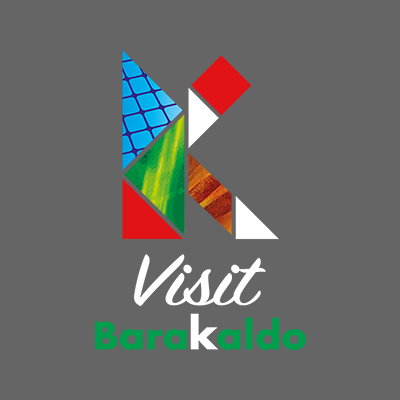The many vestiges of the past in Barakaldo make it the ideal location for interpreting the history of the industrialisation of Biscay. These traces of the industrial era permeate many buildings and sites, which remain as symbols of a difficult but also hugely important time that has since been left behind. A rich industrial heritage, which has been catalogued and protected, together with other places of interest, can be visited on this urban industrial route. From the Munoa Estate and Palace, commissioned by Rafael Echevarria and Amailia Echevarrieta to the architect Ricardo Bastida in 1916, declared a Monumental Ensemble, to the workers’ housing and the old abattoir, passing through the Monumental Ensemble of the iron ore quay and loading docks, and the Franco-Belgian, Orconera Iron Ore and Sefanitro loading bays. An evocative walk through the industrial history of Barakaldo, with many fascinating sights to see, far removed from the usual tourist routes.
Route: 2,5 Km
Access: Barakaldo
ROUTE
01 Gasolino Barakaldo-Erandio (Quay)
02 Ilgner Building
03 Headquarters of Altos Hornos de Vizcaya
(AHV)
04 RENFE Station
05 Corn Exchange
06 Modernist, Neo-Basque, Eclectic and
Rationalist Houses (Calle Murrieta)
07 Calle Arana, First Workers’ Housing
08 Paseo Dolores Ibarruri
09 Workers’ Housing “La Tribu Moderna”
(Calle Oleta)
10 Workers’ Housing “La Providencia”
11 Workers’ Housing “El Ahorro” (Gabriel Aresti)
Bagatza Station
12 Former Abbatoir
13 Wholesale Market
14 Homage to Industry, Herriko Plaza
Barakaldo Station
01- Gasolino Barakaldo-Erandio (Quay)
In 1830, Don José María Jado bought several plots of land in Erandio, taking over ownership of the ticket office and management of the river ferry. At the end of 1940, diesel engines were installed to make the passage between the banks faster and safer and it became known as the “gasolino”.
02- Ilgner Building (1926)
Electrical processing building constructed in 1926 that served the AHV facilities. After careful restoration, it now houses the headquarters of BIC Bizkaia Ezkerraldea. Don’t miss a visit inside.
03- AHV Headquarters
These are two semi-detached buildings, from different periods, which were used as the headquarters of Altos Hornos de Vizcaya for many decades. They provide an idea of the growth of this company throughout the 20th century.
04- RENFE Station
Declared a monument in 2008. Designed by the engineer Pablo Alzola, it maintains all the elements of a second-class station. In 1923, the engineer Enol remodelled the station to add another level. Today, Barakaldo-Desierto is one of the few original stations on the line that is still active.
05- Corn Exchange
Inaugurated in the 1950s, this building housed 8/9 social housing units and warehouses on the ground floor. It was later used as a school for adults and as the headquarters of the food bank. It is now being used for the 21st-Century Apprenticeship School.
06- Murrieta Houses
A number of houses that illustrate the architectural wealth of Barakaldo can be found on Calle Murrieta. There are many different styles, including modernist buildings from between 1914 and 1924, designed by one of the great architects of the time, Santos Zunzunegui.
07- Calle Arana. First Workers’ Housing
This project was promoted by the Arana Society and carried out by Edesio Garamendi (1888). It entailed the construction of a private street, measuring eight metres across and consisting of a group of twelve residential buildings. Most of them have three bedrooms, a living room, a kitchen and a toilet.
08- Paseo Dolores Ibarruri
Former railway line belonging to the Franco-Belgian mining company, inaugurated in 1880. It was 7 km long. It started at Arroyo Granada, in the municipality of Ortuella, and ended at the Estuary of Bilbao. Today, part of the route is a cycle path named after Dolores Ibarruri, “La Pasionaria” (“The Passionflower”).
09- Workers’ Housing “La Tribu Moderna” (“The Modern Tribe”)
Project signed by Ismael Gorostiza. Fifty dwellings were built next to the Franco-Belgian railway line, which is now Paseo Dolores Ibarruri. The developers were workers and employees at AHV. They paid with a contribution in cash and working hours. The houses measure 74 m2 divided over 2 floors.
10- Workers’ Housing “La Providencia” (“The Providence”)
In the first third of the 20th century, an attempt was made to improve the housing problem caused by the massive influx of workers with the construction of residential complexes such as “La Tribu Moderna” (Calle Ferrerías, Bagatza), “La Providencia” (Santa Teresa), “La Felicidad” and “El Ahorro” (Gabriel Aresti).
11- Workers’ Housing “El Ahorro” (“The Savings”)
Architect Ismael Gorostiza introduced an exciting innovation in construction with the use of reinforced concrete beams and pillars. These buildings have an Art Deco design. The elegance of the doorways with their colourful tiles and simple geometric motifs stands out. The houses have a surface area of 75 m2.
12- Barakaldo Abattoir
Built in 1918 by the architect Alfredo Acebal, it was refurbished in 1992 to house the official language school. Another magnificent example of the renovation of an industrial building for new uses and services.
13- Wholesale Market
Traditional three-storey building with a concrete structure, which is highly emblematic for the population of Barakaldo. The façade has large openings and a combination of red brick and tiles.
14- Homage to Industry (2002)
Bronze and weathering steel sculpture, weighing 6 tonnes and standing 7.5 metres high. The plaques on the pedestal represent an ore loader, welder, blacksmith and the furnace of an ironworks.

